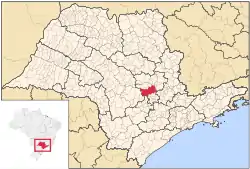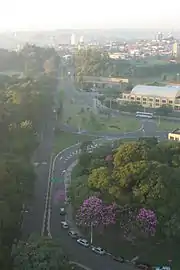Piracicaba
Piracicaba (Portuguese pronunciation: [piɾɐsiˈkabɐ] or [piˌɾasiˈkabɐ]) is a city located in the Brazilian state of São Paulo. The population is 423,323 (2022) in an area of 1,378.07 km2.[2] It is at an elevation of 547 m above sea level.
Piracicaba | |
|---|---|
.jpg.webp) | |
 Flag  Coat of arms | |
| Motto(s): Audax in intellectu et in labore (Latin) Audacious in intelligence and at work | |
 Location in São Paulo state | |
 Piracicaba Location in Brazil | |
| Coordinates: 22°43′31″S 47°38′57″W | |
| Country | Brazil |
| Region | Southeast |
| State | São Paulo |
| Government | |
| • Mayor | Luciano Almeida (DEM) |
| Area | |
| • Total | 1,378.07 km2 (532.08 sq mi) |
| Elevation | 547 m (1,795 ft) |
| Population (2022 [1]) | |
| • Total | 423,323 |
| • Density | 307.2/km2 (796/sq mi) |
| Time zone | UTC-03:00 (BRT) |
| Postal code | 13400-000 |
| Website | www |
Name
The place name comes from a word in the Tupi language that means "place where the fish stops", and it is formed by the junction of the terms pirá ("fish"), syk ("stop") e aba ("place").[3]. The name refers to the waterfalls of the Piracicaba River, which bisects the city, which is a point where the "piracema"—fish swimming upstream to reproduce— are stopped.[4]
History
In 1766, Antonio Correa Barbosa, charged with the task of establishing a settlement on the estuary of Piracicaba river, opted for a location about 90 kilometres (56 mi) from it.[5] The settlement was officially founded on August 1, 1767, as a povoação subordinated to the vila of Itu.[6] In 1784, Piracicaba got emancipated from Itu, becoming a freguesia.[6]
In 1821, the freguesia was promoted to vila, known as Vila Nova da Constituição. In 1856, Vila Nova da Constituição was promoted to city status and in 1877 it was officially named "Piracicaba", following a law by the then councilman and future Brazilian president Prudente de Morais.[6]
In 1944, the city was made the seat of the Roman Catholic Diocese of Piracicaba.[7]
Notable institutions, events, resources
Piracicaba is home to the oldest agricultural university in Brazil, the Luiz de Queiroz School of Agriculture of the University of São Paulo.[8] Founded in 1901, the school is located on a farm with a large collection of trees and plants. It is also recognized as a leader in the field of precision agriculture. Other universities based in Piracicaba are the Methodist University of Piracicaba (UNIMEP)[9] and the University of Campinas' School of Dentistry.[10]
Piracicaba is known by the nickname "Noiva da Colina",[11], meaning "Bride of the Hill", and is the annual host to the "Festa das Nações" (Nations' Party, where people may find foods from all over the world),[12] and to the "Salão Internacional do Humor" (International Humor Exhibition), where cartoonists from around the world display comic drawings.[13][14]
Piracicaba is famous for its sugarcane plantations,[15] traditional cachaça production,[16] and traditional music.[17]
Economy


The city is an important and traditional producer of sugarcane.[18] The harvest of sugarcane allows for the production of many derivates, including sugar, oil, and ethanol.[19] Copersucar, a large company that has a center of research on genetic improvement of sugarcane, participates in this growing industry.[20][21]
Another characteristic economic feature is the presence of large industries, the main ones being Caterpillar,[22] ArcelorMittal,[23] Raizen and Hyundai.[24]

Geography
Piracicaba's altitude is 554 meters.[25] Temperatures through the year vary from average highs of 30 °C to average lows of 12.0 °C, [26] and Piracicaba experiences an average annual rainfall of 123 centimeters.[27] The area of the city is 1,378 square kilometers, making it the 13th largest city in the State of São Paulo.[28] The urban area of Piracicaba is 233.36 square kilometers.[29]
Demographics
The population in 2019 was 404,142. The Human Development Index for the city was 0.710 in 2000, and 0.785 in 2010, both falling in the "high" category.[30]
Religion
Religion in Piracicaba
Like the cultural variety in Piracicaba, there are several religious manifestations in the city. It is possible to find in the city dozens of different Protestant denominations, as well as the practice of Buddhism, Islamism, Spiritism, and others. In the last decades, Buddhism and Eastern religions have grown in the city. There also are the Jewish, Mormon and Afro-Brazilian religions. According to data from the 2019 Census conducted by the IBGE, the population of Piracicaba was composed that year by Catholics (59.78%), Evangelicals (27.42%), no religious affiliation (7.47%), Spiritist (2.9%) and Jehovah's Witnesses (0.95%). The remaining 2.09% of the resident population declared themselves of other denominations or of undetermined religion.
Source: IBGE - Census 2019
Utilities
As of 2010, water and power are supplied at a level approaching 100% of the households.[31] As of 2019 there were 2.15 inhabitants per car in the city,[32] and, in 2022, roughly 0.72 inhabitants per mobile phone line, with 99% of the city's population calculated as having access to a mobile phone.[33]
Notable people
- José Altafini, also known as "Mazola", a professional footballer.
- Jonathan Cafú, footballer
- Erik Cardoso, sprinter
- Cassiano Leal, swimmer
- Evaristo Conrado Engelberg, engineer and inventor
- André Cypriano, professional fotographer and documentarist
- Ronaldo Guiaro, footballer
- Marcos Pizzelli - footballer who played for the Armenian national team.
- Rubens Ometto Silveira Mello, the owner of Cosan.
Sister cities
References
- "IBGE - Instituto Brasileiro de Geografia e Estat韘tica". ibge.gov.br. Retrieved 4 March 2016.
- Universidade de São Paulo (USP). "Vocabulário tupi-português das lições". Archived from the original on 31 May 2012. Retrieved 7 June 2012.
- URB-AL (29 August 2006). "Piracicaba/BR". Archived from the original on 23 February 2011. Retrieved 17 February 2011.
- Tecnologia, Imagenet. "Prefeitura do Município de Piracicaba". www.urbal.piracicaba.sp.gov.br (in Breton). Retrieved 2016-03-04.
- "IBGE | Cidades | São Paulo | Piracicaba | Histórico". cidades.ibge.gov.br. Retrieved 2016-03-04.
- Piracicaba, Diocese de. "Criação da Diocese | Diocese de Piracicaba". www.diocesedepiracicaba.org.br. Retrieved 2016-04-04.
- "Who we are | University of São Paulo". www.en.esalq.usp.br. Retrieved 2016-03-04.
- "UNIMEP".
- "Portal FOP-Unicamp". www.fop.unicamp.br. Retrieved 2016-10-05.
- "A "Noiva da Colina" e o véu — A Província - Paixão por Piracicaba". A Província - Paixão por Piracicaba (in Brazilian Portuguese). 16 April 2013. Retrieved 2016-03-04.
- "Festa das Naçoes de Piracicaba:33 anos de história".
- "EBC". memoria.ebc.com.br. Retrieved 2016-03-04.
- "Salão Internacional de Humor de Piracicaba | História". salaointernacionaldehumor.com.br. 8 July 2010. Retrieved 2016-03-04.
- Audi, Raul (1968). "A study on sugarcane cultures in the Piracicaba region by means of photointerpretation: Part II". Bragantia. 27 (2): 383–394. doi:10.1590/S0006-87051968000200013. ISSN 0006-8705.
- "Piracicaba volta a investir em cachaça".
- http://www.seer.ufsj.edu.br/index.php/temposgerais/article/download/1439/1080
- "A força da cana". APLA. Retrieved August 16, 2023.
- Moraes, Márcia Azanha Ferraz Dias de; Zilberman, David (2014-03-31). Production of Ethanol from Sugarcane in Brazil: From State Intervention to a Free Market. Springer Science & Business Media. p. 87. ISBN 9783319031408.
- "Centro de Tecnologia Canavieira vira S.A. e Copersucar volta ao comando". G1. 12 January 2011. Retrieved 2023-08-17.
- "Cerradão amplia para 36 o nº de sócias da Copersucar". Rural Centro. 18 December 2009. Retrieved 2023-08-17.
- "A Caterpillar no Brasil". MEMORIAL DO EMPREENDEDORISMO. 7 August 2015. Retrieved 2016-03-04.
- "Câmara homenageia Belgo - Grupo Arcelor Mittal". www.camarapiracicaba.sp.gov.br (in Brazilian Portuguese). Retrieved 2016-10-05.
- AW Staff (2011-02-28). "Brazil: Hyundai breaks ground on Piracicaba plant". automotiveworld.com. Retrieved 4 March 2016.
[Quoting:] Hyundai has launched construction on its Piracicaba plant in Brazil's Sao Paulo state. The new 150,000upa plant is Hyundai's seventh outside of South Korea. The manufacturer is investing US$600m in the Piracicaba facility, which will start production in the second half of 2012
- "LOCALIZAÇÃO, RELEVO E EXTENSÃO TERRITORIAL DE PIRACICABA" (PDF). IPPLAP. Retrieved April 4, 2016.
- "Clima e condições meteorológicas médias em Piracicaba no ano todo". Weather Spark. Retrieved August 8, 2023.
- "DADOS REFERENTES A: MEDIAS MENSAIS E TOTAL DE CHUVA - PIRACICABA - PERIODO 1917 A 2008". ESALQ. Retrieved August 8, 2023.
- "Áreas Territoriais". IBGE. Retrieved August 8, 2023.
- "Informações Gerais". IPPLAP. Retrieved August 8, 2023.
- "IBGE | Cidades | São Paulo | Piracicaba". www.cidades.ibge.gov.br. Retrieved 2019-08-29.
- "NÍVEL DE ATENDIMENTO DE ABASTECIMENTO DE ÁGUA NO MUNICÍPIO DE PIRACICABA - 1991, 2000 E 2010" (PDF). IPPLAP- Instituto de Pesquisas e Planejamento de Piracicaba. Retrieved October 4, 2016.
- "Piracicaba, Limeira e Santa Bárbara d'Oeste têm índice elevado de carros por habitantes". G1. Retrieved August 14, 2023.
- "Piracicaba tem mais números de celular do que habitantes". JP. Retrieved August 14, 2023.